Microsoft Surface Pro 4 review
The Surface Pro 4 is iterative in the best sense of the word
OUR VERDICT
Has Microsoft at last crafted a tablet that can reasonably, without considerable compromise, replace your laptop? Short of going back to the drawing board on the battery, this looks as close as it's going to get.
FOR
- Larger, sharper screen within same dimensions
- Vastly improved Type Cover
- Even better Surface Pen
AGAINST
- Type Cover still sold separately
- Intel Core m3 at entry level
- Battery life hasn't improved much
Microsoft Surface Pro 4: The Essential Review
The following section contains all of the key points of our review that you’ll need to know without having to read a full wall of text. For those seeking a try it or buy it recommendation in 30 seconds or less, keep reading – otherwise, skip to ‘Design and display’.
After pervading the market two years ago, the Microsoft Surface Pro 4 remains a Windows 10 fan favorite. Sure, we saw the introduction of the aptly-named Surface Pro in the first half of the year, but the changes weren’t substantial enough to get most of our readers excited.
The Surface Pro 4 was the natural progression of the Surface Pro 3 and the Surface Pro 2 before it. It’s a 2-in-1 laptop in form and a Windows tablet by name, but perhaps its biggest sell is that it’s the first in the series to come with Windows 10 Pro pre-installed. This was huge and still is, considering Surface Pro 3 users were stuck with the controversial Windows 8 unless they opted to perform an upgrade themselves.
With the Surface Pro 4, however, Microsoft was more concerned with perfecting an already-successful design rather than making any bombastic innovations. That’s why it basically retains a similar look and feel to that of the Surface Pro 3, albeit with a few minor refinements including a new chrome-laden Microsoft logo and a chassis more than half a millimeter thinner than the previous generation.
The Surface Pro 4 also managed to introduce more levels of pressure sensitivity and a host of buttons to the signature, but sold separately, Surface Pen. Likewise, the Type Cover keyboard is heavier and more satisfying to the touch, while the screen resolution was bumped all the way to 2,736 x 1,824, making it 216 pixels per inch (ppi), as opposed to the 128 ppi display of the 13-inch MacBook Air.
To be frank, the most impressive aspect of this laptop, more so than any of the iterative refinements, is that the Surface Pro 4 stays well within the same modest price range as its precursor. That’s $799 (£749, AU$899) to start, without the Surface Pen and Type Cover keyboard, though Surface Pen bundles can be found from $999 (£749, AU$1,178).
The biggest drawback for the Surface Pro 4, however, is how difficult it is to find. Unless you’re keen on settling for the basic configuration, with an Intel Core m3 CPU, 4GB of RAM and 128GB of SSD storage space, you won’t find it on the Microsoft Store website – and it’s only available refurbished on Amazon. Regardless, it’s definitely worth it – especially on a budget.
Whereas you can expect to pay $799 (£799, AU$1,199) for an entry-level, fifth-gen Surface Pro with an Intel Core m3 processor paired with 4GB of RAM and 128GB of SSD storage space, you could get a Surface Pro 4 with a possibly more capable Intel Core i5 processor along with the same amount of RAM and storage space for $200 less.
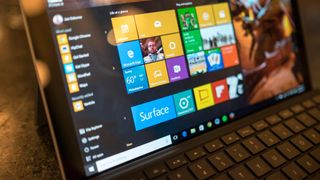
Microsoft Surface Pro 4: Who's it for? Should I buy it?
The Surface Pro 4 appeals to a wide variety of consumers. So, whether you’re a graphic designer or a college student – even, say, an aspiring tech reporter, Microsoft has conjured a fantastic tablet that doubles as an equally great laptop.
So, has Microsoft finally done it? Well, despite the ‘somewhat average battery life’ and the fact that the Type Cover has to be purchased separately unless it’s bought as part of a bundle, we could easily see the Surface Pro 4 as our daily driver. Regardless, it would’ve been nice to have that LTE chip Microsoft reserved for the new Surface Pro with LTE Advanced, available now.
Nevertheless, we adore the sharper, larger display and lighter frame, with the improved Type Cover taking it all to the next level. Still, the fact that the Type Cover still isn’t included by default is a big issue, especially given how essential it is to the core experience of the laptop. More aggravating is that the battery life hasn't improved much either – one of the low points of the previous model.
Despite having come a long way since its reveal two years ago, the Surface Pro 4 is still due for some improvements. The Windows 10 Fall Creators Update, for example is now available to download and install, and it comes with a generous helping of long-requested features including ‘Sets’, or tabs for the apps you use outside of your browser.
Likewise, we can count on more hardware updates later on down the road, given that the Surface Book 2 is now in stores.
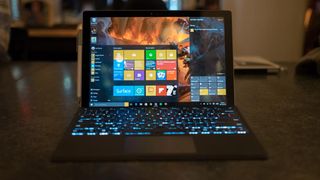
Design and display
SPEC SHEET
This is the Surface Pro 4 configuration sent to TechRadar for review:
CPU: 2.4GHz Intel Core i5-6300U (dual-core, 3MB cache, up to 3GHz with Turbo Boost)
Graphics: Intel HD Graphics 520
RAM: 8GB LPDDR3
Screen: 12.3-inch, 2,736 x 1,824 PixelSense display (Contrast ratio: 1,300:1, 100% sRGB color, 10-point multi-touch, 3:2 aspect ratio)
Storage: 256GB SSD (PCIe 3.0)
Ports: 1x USB 3.0, mini DisplayPort, microSD card reader (UHS-I), headphone/mic jack
Connectivity: 802.11ac Wi-Fi (2 x 2 MIMO), Bluetooth 4.0 (Low Energy)
Cameras: 8MP rear-facing, auto-focus camera (1080p HD); 5MP front-facing, 1080p HD camera
Weight: 1.73 pounds (786g)
Size: 11.5 x 7.93 x 0.36 inches (292.10 x 201.42 x 8.4mm; W x D x H)
Graphics: Intel HD Graphics 520
RAM: 8GB LPDDR3
Screen: 12.3-inch, 2,736 x 1,824 PixelSense display (Contrast ratio: 1,300:1, 100% sRGB color, 10-point multi-touch, 3:2 aspect ratio)
Storage: 256GB SSD (PCIe 3.0)
Ports: 1x USB 3.0, mini DisplayPort, microSD card reader (UHS-I), headphone/mic jack
Connectivity: 802.11ac Wi-Fi (2 x 2 MIMO), Bluetooth 4.0 (Low Energy)
Cameras: 8MP rear-facing, auto-focus camera (1080p HD); 5MP front-facing, 1080p HD camera
Weight: 1.73 pounds (786g)
Size: 11.5 x 7.93 x 0.36 inches (292.10 x 201.42 x 8.4mm; W x D x H)
Just like last time, the same all-magnesium, uni-body casing is still here, though the 'Surface' logo has been replaced with Microsoft's new logo in chrome.
Microsoft managed to up the device's screen size by a few hairs, from a straight 12 inches to this year's 12.3 inches, without affecting its footprint at all. In fact, the firm shaved more than half a millimeter off of its thickness, from 9.1mm to 8.4mm – all while fitting full-fat mobile processors.
As for how this was done, the capacitive Windows button said goodbye, thus the extra room for that three tenths of an inch in the display.
Then, Microsoft brought the screen's optical stack – the series of sensors, diodes and pixels beneath the glass – even closer to the glass now, a key point of Microsoft's trademarked PixelSense screen technology.
The display is thus incredibly responsive to touch, and the further sensitivity it brings to the stylus experience is huge. In tandem with the improved Surface Pen, the screen detects 1,024 levels of pressure, even during a single stroke.

Now, let's talk resolution. Even though it didn't have to, Microsoft increased the Surface Pro 4's resolution from 2,160 x 1,440 (216 ppi, or pixels per inch) to 2,736 x 1,824. That makes for a huge 267 ppi for the Surface Pro 4, which blows a key rival, the MacBook Air (128 ppi for the 13-inch), out of the water and just barely beating out out Apple's 12.9-inch iPad Pro at 264 ppi.
More importantly, the new screen proves to be way more luminous and more color accurate than the Surface Pro 3 display at all brightness levels. This is obviously going to be a pretty big deal for any designers or artists that are looking to upgrade from the Wacom tablet and calibrated monitor combo.
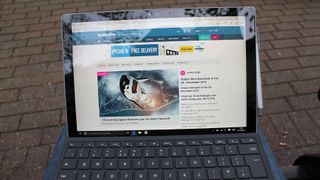
For the rest of us, this means more realistic-looking movies and more vibrant photos and games. That's despite even thicker black bars sandwiching your favorite films in 16:9 – and even more so for those in 21:9, or widescreen format, thanks to the 3:2 aspect ratio that remains from last generation.
It's a fair concern for folks that watch plenty of movies and TV on a tablet. But fear not, workers, for you're the very reason Microsoft made this decision. The 3:2 aspect ratio is a middle ground between 16:9 and 4:3 that is ideal for both photo and design or drafting work, wherein 3:2 is much more common, as well as getting computational work done, given the extra vertical space.
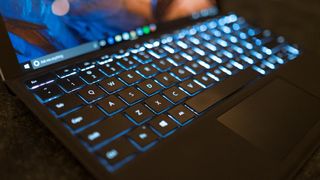
Surface Pen and Type Cover
In addition to the aforementioned 1,024 levels of pressure sensitivity, the new-and-included Surface Pen is redesigned to feel more like a pencil. The stylus now has one flat side, as if a Number 2 pencil had all but two of its angles rounded off.
This version is even more comfortable to hold than the last as a result – your index finger rests just above the main function button on the flat end. Secondly, the left side of the frame is coated with thin, powerful strip magnets that allow it to cling onto the tablet's left side. The age of stylus loops is over.
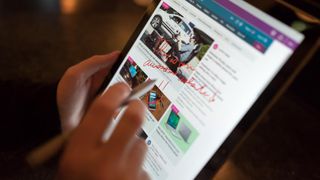
The Pen also sports a new, functional eraser button up top that does what it says on the tin, but has three more functions. In addition to opening OneNote with a single press, the button now takes a screenshot and then opens OneNote with a double press. Finally, a long press summons Cortana to help you out.
Microsoft seems to have expertly weighted the Surface Pen to make it feel not much heavier than your average clickable pen, despite all of the tech inside. Plus, now Microsoft offers additional pen tips right out of the box.
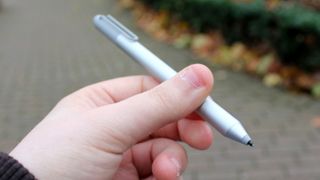
Coupled with Microsoft's PixelSense display, the duo makes for the best stylus experience we've had on a tablet yet for as little as we're wont to use it. While we're neither artists nor designers, the screen's superb palm detection and the accuracy and nuance of the Pen tracking give us confidence that the Surface Pro 4 is Microsoft's best shot at luring in that crowd yet.
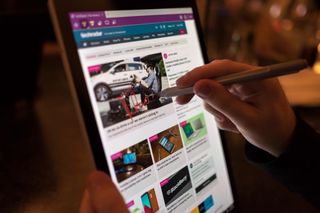
These improvements pale in comparison with Microsoft's new-and-still-not-included Type Cover. This time around, Microsoft took a chiclet-style approach. This makes keeping track of which keys your fingers are on by feel much easier, and it allows for each key to be individually back lit.
The new Type Cover is also thicker and far more rigid than before, allowing for deeper key travel and punchier feedback – not to mention a sturdier, quieter surface to type on – that brings it so much closer to a true laptop keyboard. Microsoft also widened the touchpad and coated it in glass rather than plastic.
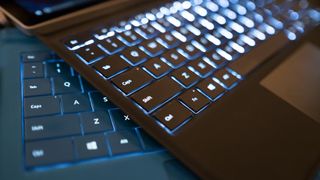
Finally, Microsoft has a version of the Type Cover with a biometric Fingerprint ID for $159 (£149, AU$249). The new keyboard cover is only available in black and uses Windows Hello to login to the Surface with a fingertip press. The scanner can also authorise app purchases from the Windows Store, and because the keyboard is backwards compatible, it can be used with the Surface Pro 3 too.
Performance
BENCHMARKS
Here’s how the Surface Pro 4 performed in our suite of benchmark tests:
3DMark Cloud Gate: 5,873; Sky Diver: 3,673; Fire Strike: 856
Cinebench CPU: 305 points; Graphics: 37 fps
Geekbench 3 Single Core: 3,135; Multi-Core: 6,649
PCMark 8 Home: 2,406
PCMark 8 Battery Life: 3 hours, 15 minutes
Cinebench CPU: 305 points; Graphics: 37 fps
Geekbench 3 Single Core: 3,135; Multi-Core: 6,649
PCMark 8 Home: 2,406
PCMark 8 Battery Life: 3 hours, 15 minutes
Every performance score here, save for PCMark 8 Home, shows a minor increase from the first unit I tested. It's a good sign that the Surface Pro 4 was already operating at its peak, and that only the battery needed fixing.
The Surface Pro 4 bested the 2015 HP Spectre x360 in almost every test by roughly 25%. As for the 13-inch MacBook Air, its multi-core Geekbench 3 (which tests CPUs primarily) score is plenty short of what the Surface achieved.
Ultimately, don't expect to see a major difference between how any of these three machines perform day-to-day, though the MacBook Air will last way longer on a charge. If anything, you might get slightly better frame rates out of games played on the Surface Pro 4 than that 2015 Spectre x360.
If you're curious, the Pro 4 runs Hearthstone (our go-to tablet testing game) without a hitch on its highest settings, even at an automatically-adapted resolution. Plus, the color-calibrated display makes every element on the game's interactive play boards that much more distracting.
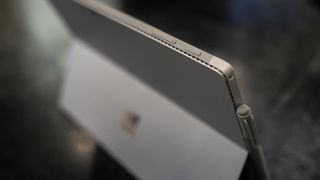
Battery life
Tested on pre-production hardware that we were promised has been scrubbed of its battery woes, the Surface Pro 4 produced far better battery life results than at the onset. Unfortunately, they're still well below not only Microsoft's own claims, but what choice rivals are able to put up.
While arguably the most harsh battery test in our lineup, PCMark 8 Home Battery saw the Pro 4 last 3 hours and 15 minutes, a marked 50% increase from before. Still, the Spectre x360 held out in that test for 4 hours and 38 minutes.
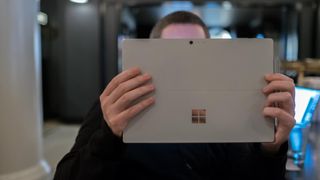
Microsoft's tablet fared much better on our video playback test, lasting 5 hours and 15 minutes. That's enough to last you on most coast-to-coast US flights.
In a similar test, the MacBook Air was able to stream 1080p video over Wi-Fi for a whopping 13 hours and 24 minutes. Though, that's thanks to a far lower-resolution display and likely a larger battery.
Regardless, Microsoft promises up to 9 hours of video playback, and these numbers aren't close. Sure, these figures are far better than last year's Surface Pro 3, despite the serious screen resolution bump, which should not be overlooked. But, they still can't hold a candle to neither Apple's leading laptop nor its top tablet – much less comparable Windows hybrids.
Longevity is then about the only thing holding the Surface Pro 4 back from truly, honestly replacing your laptop – or at least your MacBook Air specifically. Otherwise, the machine offers somewhat below-average lasting power.








0 comments: